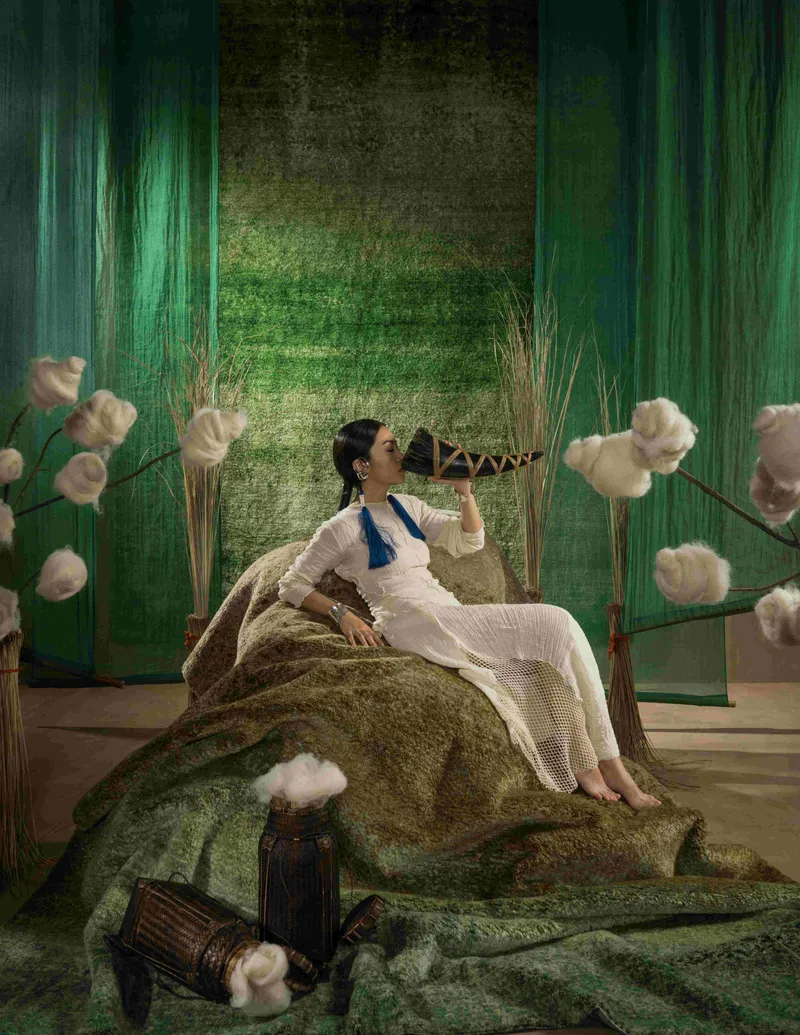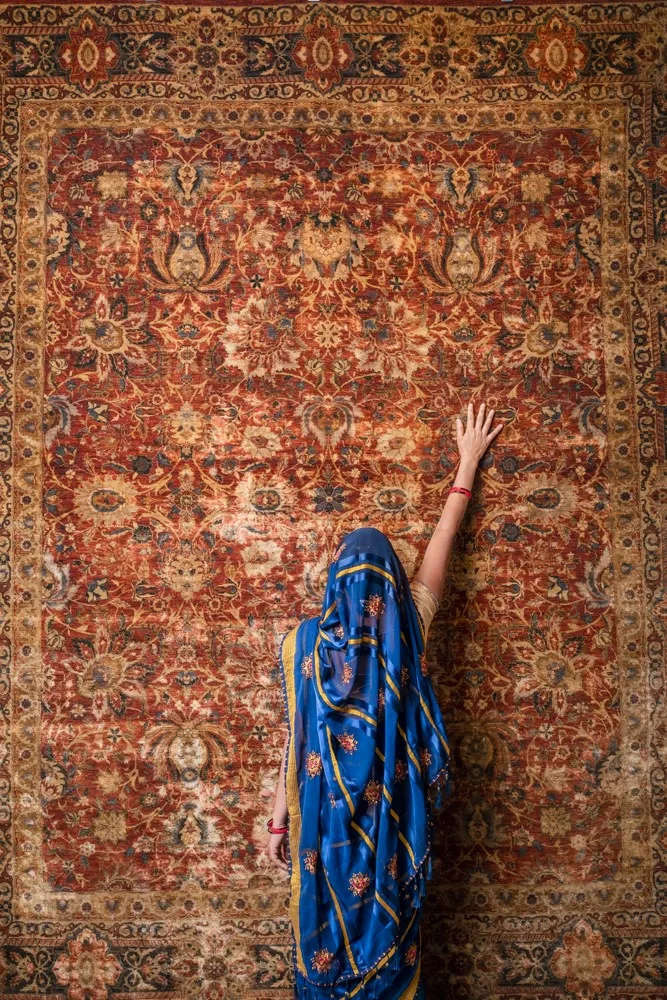How the century-old OBEETEE Carpets is redefining luxury
In a chat with Angelique Dhama, CEO of OBEETEE Carpets (Retail), we go behind the scenes to understand what makes each carpet so coveted and splurge-worthy.
Carpets and rugs may have become the new symbols of opulence and luxury, but their history is ancient, punctuated with fascinating tales.
It is believed that hand-knotted rugs have been around for thousands of years, with the Pazyryk Persian rug dating back to the 4th century BC. Earlier, rugs were used both as floor coverings as well as a cover to provide warmth to nomadic people across East Asia and the Middle East.
With time, as the Persian empire spread its wings to India, with Babur laying the foundation of the Mughal rule, hand-knotted rugs came into prominence in India. Some of the Persian carpet weaving centres were based around Agra, Delhi and Lahore. Research suggests that the initial designs were inspired by Persian motifs that depicted animals, floral patterns, as well as life in the royal courts. Over time, there was also an influence of Indian culture observed in the designs.

OBEETEE Carpets X Tissage Chroma collection
After the end of the Mughal rule, the rug and carpet making industry faced several trials and tribulations. It is believed that its revival happened in the last few years of British rule.
However, not many establishments have survived and thrived in the country. One of the notable exceptions is OBEETEE Carpets.
Founded as Oakley, Bowden and Taylor in the dusty town of Mirzapur in Uttar Pradesh way back in 1920, it is one of the oldest and largest handwoven rug companies in India, and the world. Over time, it has expanded to become the last word in refined luxury and exceptional craftsmanship.
The brand’s uniqueness and regality have been acknowledged globally, with some of its creations adorning the Rashtrapati Bhavan as well. OBEETEE’s patrons over the years include Queen Elizabeth II, Jawaharlal Nehru, and Amitabh Bachchan.
Angelique Dhama, CEO of OBEETEE Carpets (Retail), in a chat with YS Life, dives deep into the brand’s illustrious history and what makes it so opulent.
Edited excerpts from the chat …
YS Life (YSL): Tell us more about the inception of OBEETEE Carpets, one of the world’s oldest carpet companies.
Angelique Dhama (AD): Post World War I, British individuals FH Oakley, FH Bowden, and JAL Taylor gathered local craftsmen, forming OBEETEE. With a legacy dating back to Emperor Jahangir's reign in the 16th century, OBEETEE’s journey endured challenges, migrations, and foreign interest in the late 19th century.

OBEETEE carpets X Tissage Chroma collection
Today, OBEETEE stands as a symbol of tradition and innovation, employing 25,000 artisans. The company’s commitment to excellence is reflected in its creations that adorned several prestigious and opulent spaces in its century-long journey.
Additionally, the brand has preserved a generation-old craft of hand-weaving and hand-knotting alive, even in the 21st century. This factor has undoubtedly contributed greatly towards the global recognition of the brand for the quality and uniqueness it provides.
OBEETEE operates in India and the US, with plans for UAE, Riyadh, and other potentially lucrative markets.
YSL: What makes the product so luxurious?
AD: The brand’s rugs, being hand-woven, carry the legacy of centuries-old craftsmanship from Mirzapur, India, a town renowned for rug making. The expertise passed down through generations ensures a level of artistry and attention to detail that machine-made products often lack.
The dedication of the company to social responsibility and ethical practices adds to the allure. This blend of tradition, innovation, and ethical sourcing contributes to the luxurious appeal of OBEETEE products, making them not just décor accents but also statements of heritage and responsible craftsmanship.
YSL: Take us through the process of making each carpet—from the materials used to the number of people involved in each project.
AD: The time required to make each product varies depending on the complexity of the design and size, but generally, hand-woven rugs can take weeks to months to complete.
The materials used in OBEETEE carpets primarily include high-quality wool sourced from the brand’s extensive palette of over 4,000 colour-fast shades. The brand’s modern dyeing plant ensures vibrant and lasting colours, contributing to the overall richness of the final product.

OBEETEE carpets X JJ Valaya from the Proud to be Indian collection
The number of people involved in making one carpet depends on the size, the weave, and the intricacy of the design.
For example, a single 9x12 hand-knotted carpet generally requires one or two craftsperson(s). This is because the loom on which the carpet is knotted can only, in most cases, accommodate two people. The time to make this carpet would take anywhere from 6 to 12 months depending on the complexity of the design.
YSL: Tell us about the different collections that OBEETEE offers. What’s your most luxurious product?
AD: Notable collections include the ‘Proud to Be Indian’ series, achieved through collaborations with renowned Indian designers such as Tarun Tahiliani, Shantanu and Nikhil, Raghavendra Rathore, Abraham & Thakore, and JJ Valaya.
The recently launched collection ‘Chroma People’, in collaboration with Tissage Rugs, is another premium range that the brand has added to its rich portfolio of collections. Being a venerable 102-year-old brand, OBEETEE boasts an ever-evolving range of carpets, offering a diverse spectrum of designs.
One of the most luxurious collections is undoubtedly our Revisiting Classics since it features intricate designs and rare materials inspired by traditional Persian techniques.
YSL: Do you believe the market is moving towards high-end luxury post-COVID-19, particularly when it comes to home decor?
AD: In the post-COVID era, there has been a noticeable trend towards high-end luxury in the home decor market. Consumers are placing a greater emphasis on creating luxurious and comfortable living spaces, possibly influenced by extended periods spent at home during lockdowns. The increased focus on home as a sanctuary has led to a growing demand for premium and aesthetically pleasing decor items.
Luxury home decor items are seen as more than just functional; they are regarded as statements of style, status, and personal taste. People are investing in quality furnishings, unique pieces, and exclusive designs to elevate their living environments. Notably, luxury brands in the home decor sector have experienced a surge in interest and sales.

YSL: What are some milestones in OBEETEE’s century-long journey?
AD: OBEETEE’s journey from its inception in 1920 to the present day is marked by a kaleidoscope of growth, challenges, and milestones.
In the early 20th century, the company began in Mirzapur, India, with British founders uniting local craftsmen under the OBEETEE banner. Despite turbulent times, the carpet industry flourished, and skilled weavers migrated to Madhosingh in the late 19th century.
Prestigious projects, such as collaborations with Indian designers and involvement in the Central Vista Project, showcase OBEETEE’s commitment to representing India’s rich artistry.
Accreditations like Fairtrade, GoodWeave, Woolmark, RWS, SA8000, and FernMark underscore OBEETEE’s commitment to social responsibility, sustainability, and quality, reinforcing its global standing.
YSL: What’s in the pipeline for OBEETEE?
AD: Next in the pipeline for OBEETEE are strategic expansions and innovative ventures aimed at solidifying our position as a global leader in luxury handwoven rugs and home decor. The brand already has flagship stores in prominent Indian cities such as Delhi, Hyderabad, Kolkata, and Mumbai.
OBEETEE’s global ambitions were showcased at the 2023 Riyadh Exhibition, indicating its intent to capture markets beyond India. The brand is actively looking to expand its operations to the United Arab Emirates, Riyadh, and possibly more international destinations.
Diversification is another key aspect of OBEETEE’s future plans. The brand is not limiting itself to carpets alone; it is venturing into various decor categories, including cushions and furniture. Collaborations will continue to be a focal point for our future endeavours. The brand has a track record of collaborating with renowned designers and artists to create exclusive collections that blend Indian craftsmanship with contemporary design trends.
Edited by Swetha Kannan







